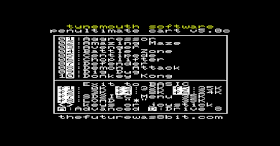This is an old post, preserved for reference.
The products and services mentioned within are no longer available.
Here in the UK, I have loads of PAL VIC20s, but no NTSC versions, and I was looking for one to use for testing the Penultimate Cartridge, it turned out that Paul Rickards was in the USA with a selection of NTSC VIC20s, and was interested in a PAL one, so we concocted a plan to swap one. Rather than sending a whole VIC20, we just exchanged crystal, VIC chip and kernal ROM. That should be easy enough, just swap those bits over and away you go. Here's is Paul's proof that his NTSC VIC20 is working:
Here is the matching proof from my TV that my VIC20-CR is indeed PAL.
The photo Paul sent of the NTSC version looks very similar to my PAL version, doesn't it?
Well, looking closer at the photo of the NTSC and PAL versions of the VIC20-CR, there are quire a few differences.
The NTSC version has a PCB trace linking pins 2 and 4 of the 7402. The PAL version has the trace cut and a 1nF capacitor fitted
Capacitor C13 is a 220pF ceramic disc capacitor on the NTSC version, which should be horizontal in the outline in the centre of the picture below. On the PAL version, it is not fitted, but a 220pF axial capacitor is connected at 45 degrees between one pad of C13 and the top of R10.
The NTSC version has two ferrite beads, FB4 and FB5 (bottom right). On the PAL version, there is 1 ferrite bead and one yellow wire and they are crossed over.
Finally, on the back of the board, on the PAL version only, a 56pF ceramic disc capacitor is soldered across R5.
I have not been able to locate a decent schematic for the PAL version of the VIC20-CR, and only some ropey scans of the NTSC version, this is stitched together from two of those scans to show the video output section.
I have marked on the differences that have been made to the PAL version. All the PAL VIC20-CR boards I have checked have these same modifications. It's surprising that they must have made hundreds of thousands with these mods, rather than designing a PAL specific board, or even a dual purpose one could easily be made for either standard.
In order to convert my PAL VIC20 to NTSC, I need to get from that modified schematic back to the original. I removed the modified parts and assembled a pack of bits to send over to Paul so that he could do the reverse, and convert an NTSC VIC20-CR to PAL.
There were a few less parts for the reverse conversion, these are the NTSC bits I got back, for my PAL to NTSC conversion. The markings have rubbed off the 14.31818 MHz crystal. It has an unusual central ground pin, but the PCB is designed for a 2 or 3 pin crystal.I had already removed the PAL specific parts, so all I had to do was fit a new 220pF capacitor as C13, replace the cut track next to the 7402 with a wire link, and install the two ferrite beads, FB4 and FB5 (borrowed from a scrap board). Finally, the NTSC crystal, VIC and ROM.
Once all that was done, it looked fairly close to the original version, and worked first time. It still needs a bit of tweaking, but it's a reasonable NTSC picture.
The TV confirms the signal is now NTSC. Time to install a Penultimate Cartridge and do some testing. Many people are already using it on NTSC VIC20s, but it's nice to be able to test it myself. The yellow comes out better than the PAL version, as does the red below.
More testing is required, but all is working well so far with the converted VIC20. One of the first things you notice is that some cartridge games which used to start offset to the left now start properly centred. Oh dear, I guess I'm just going to have to play some more Donkey Kong.
UPDATE:
The PAL bits have now arrived in the states, and Paul's NTSC machine has now been converted. FB4 removed and one end of FB5 swapped over to the end of FB4 end a wire link fitted from the spare end of FB4 to the spare end of FB5, C13 removed and the new 220nF axial capacitor fitted linking to the top of R10, the track between pins 2 and 4 of the 7402 broken and a 1nF capacitor fitted between the two vias, and finally a 56pF capacitor added on the back across R5.
With the PAL crystal, VIC and ROM now installed, the ex-NTSC machine is running as a PAL machine.
Everyone's a winner!



























































